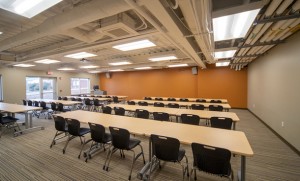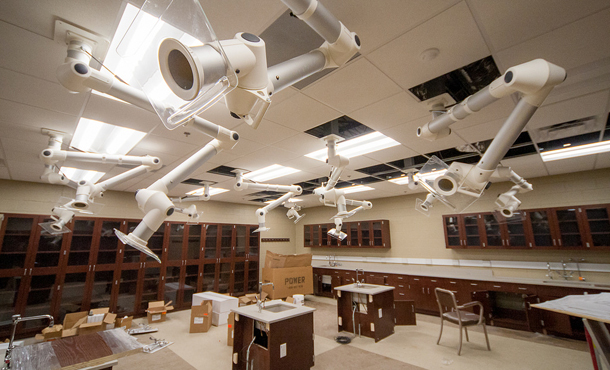Still smelling of fresh paint, new additions and renovations to Eastern Mennonite University’s Suter Science Center are due to open for the spring semester today.
The $7.3 million project’s first and second phases are complete, and the third stage will begin this month, according to project leaders.
Students will be able to use some classrooms on the south and east sides of the building, including lab facilities. Blue Ridge Architects is conducting the work and project manager Welby Lehman said crews have renovated about 17,000 square feet of the building to date, while the third project phase will renovate another 8,000 square feet.
With the renovations, EMU hopes to boost its STEM — science, technology, engineering and math — research, specifically in biology and chemistry programs.
The first phase included two classrooms, stairwells and elevators, the last of which Lehman said the center did not previously have. The second phase included four classrooms for biology and chemistry, two engineering classrooms and a dissection room.
Crews also widened hallways and made the north-south corridor a “science concourse.” The concourse will have chalkboard and dry erase wall surfaces for students and faculty to write on, and furniture will be dispersed throughout the space.
“We hope that that becomes the hub of activities for the science building,” Lehman said.
The center’s south and east wings have larger windows compared to older parts of the building, as well as skylights above the science concourse.
Lehman said he hopes the building will be easier to navigate and will have better natural light with the new design.
Daryl Bert, EMU’s vice president of finance, said the project, which is funded entirely by donations, is “trending on budget.” Suter Science Center is nearly 45 years old and Bert expects the renovations to have a 20- to 30-year life span.
Despite a lack of budgetary hiccups since construction began last year, Lehman said crews did encounter some problems with working around faculty’s schedules and the site’s soil.
When crews built the new foundation, Lehman said they “had to dig deeper than we would have otherwise,” because of the soil composition, but that it was “not a big problem.”
During the third phase, workers will build three more classrooms and install eight chemical fume hoods, one of which is in a chemistry classroom completed as part of the second phase.
Courtesy of the Daily News Record, Jan. 5, 2015
